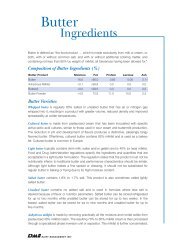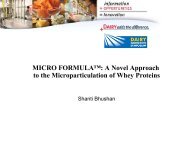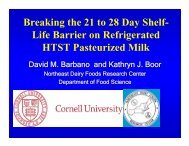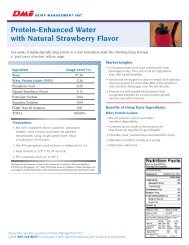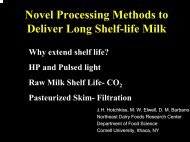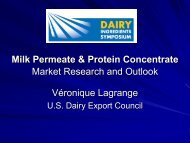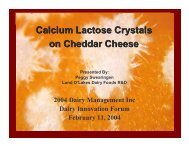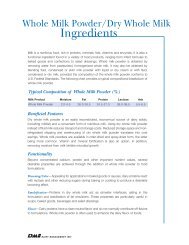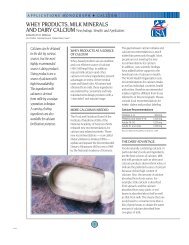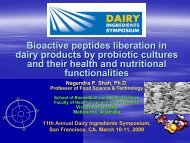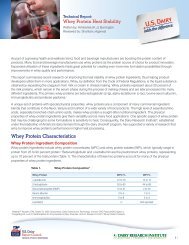Emerging Milk Protein Opportunities - InnovateWithDairy.com
Emerging Milk Protein Opportunities - InnovateWithDairy.com
Emerging Milk Protein Opportunities - InnovateWithDairy.com
You also want an ePaper? Increase the reach of your titles
YUMPU automatically turns print PDFs into web optimized ePapers that Google loves.
Enriched <strong>Protein</strong> Fractions via<br />
Supercritical Carbon Dioxide<br />
Research indicates that when supercritical carbon dioxide is incorporated<br />
in the process of fractionating whey proteins directly from milk, the result<br />
is a viable method for isolating alpha-lactalbumin and beta-lactoglobulin<br />
ingredients. Supercritical carbon dioxide is pressurized carbon dioxide at<br />
temperatures greater than 31.1°C and pressures greater than 7.39 MPa.<br />
Membrane filtration equipment at the WCDR.<br />
are simpler and much less costly to operate,<br />
providing ingredient processors options to<br />
fractionate milk.”<br />
Keeping it cold<br />
Lucey’s research team explored microfiltration<br />
of whole milk as a way to fractionate proteins.<br />
They found that even when filtered cold (at<br />
less than 7°C), whole milk <strong>com</strong>pared favorably<br />
with skim milk in terms of membrane flux and<br />
permeate rates of whey proteins derived directly<br />
from milk, but without damaging the fat.<br />
The integrated process they developed starts<br />
with microfiltration of cold whole milk to create<br />
beta-casein-reduced milk that could be used<br />
for cheese production or casein concentrates,<br />
and a permeate containing beta-casein and<br />
whey proteins derived directly from milk.<br />
The permeate then goes through additional<br />
membrane filtration steps to produce two<br />
streams: one with whey proteins, the other<br />
with enriched beta-casein. The beta-casein<br />
fraction can be concentrated to produce<br />
a product with 80 percent beta-casein.<br />
Currently, there is no <strong>com</strong>mercially available<br />
beta-casein product available. The beta-casein<br />
concentrate produced at the WCDR is free of<br />
the things that get added in the cheesemaking<br />
process (e.g., color, rennet or starter culture).<br />
The beta-casein concentrate has excellent<br />
foaming properties, emulsification and<br />
heat stability.<br />
In further work, the researchers used raw<br />
whole milk for the fractionation process,<br />
which could be useful in the purification of<br />
heat-sensitive proteins.<br />
“All process streams are highly functional –<br />
there are no waste products,” Lucey says.<br />
“This research points the way to generating<br />
more revenue by creating multiple valueadded<br />
dairy ingredients from a single,<br />
integrated process.”<br />
These enriched fractions are ideal for use in sports drinks, snack bars,<br />
confectionary, encapsulation, bakery products and a variety of foods that<br />
support the health of the elderly. In addition, beta-lactoglobulin is valuable<br />
for its gelling properties in surimi-type products, puddings, and many<br />
health and wellness products.<br />
Unlike other methods to isolate these proteins, which included chemically<br />
based separation or reverse osmosis, the supercritical carbon dioxide<br />
method does not require solvents or leave a residue.<br />
“This process eliminates the addition of chemicals to the whey, so it<br />
reduces the number of processing steps necessary to clean the products,”<br />
says Peggy Tomasula, research leader, and Laetitia Bonnaillie, researcher,<br />
both for the U.S. Department of Agriculture’s Agricultural Research Service<br />
- Eastern Regional Research Center. “In addition, the process uses less<br />
water — owing to a concentrated feed stream and no need for washing —<br />
and the carbon dioxide can be recovered and reused.”<br />
How it works<br />
In this process, whey protein isolate or whey protein concentrate is<br />
forced into a reactor simultaneously with the supercritical carbon dioxide<br />
charge. Under the right temperature and pressure in the reactor, alphalactalbumin<br />
aggregates and beta-lactoglobulin stays in solution, creating<br />
two ingredient streams.<br />
Integrated INTEGRATED Carbon CARBON dioxide DIOXIDE (COMILK-FRACTIONATION PROCESS<br />
2<br />
) milk fractionation process<br />
Whole <strong>Milk</strong><br />
Skim <strong>Milk</strong><br />
MPC<br />
Cheesemilk<br />
Other <strong>Protein</strong>s<br />
Solution<br />
WHEY<br />
MF/UF<br />
LACTOSE<br />
WPC<br />
WPI<br />
High Pressure<br />
CO 2<br />
Reactor<br />
38°C<br />
5.5 MPa<br />
High Pressure CO 2<br />
Supercritical CO 2<br />
Reactor<br />
> 60°C<br />
> 7 MPa<br />
Pressure<br />
Step Down<br />
Casein<br />
Modified Casein<br />
<strong>Protein</strong> Isolates<br />
Soft Cheese<br />
Accelerated Ripening<br />
Non-Dairy <strong>Protein</strong>s<br />
WHEY<br />
alpha-lactalbumin enriched product<br />
beta-lactoglobulin enriched product<br />
The future of supercritical carbon dioxide<br />
for fractionation<br />
Researchers are continuing to study aggregation kinetics and modeling<br />
in order to maximize the efficacy of the protein separation, as well<br />
as minimize the time, energy and equipment costs incurred in the<br />
production of fractions using supercritical carbon dioxide. Future studies<br />
will look at optimizing the whey protein’s functionality and increasing<br />
carbon dioxide recovery.<br />
<strong>Milk</strong> <strong>Protein</strong> <strong>Opportunities</strong> 7



